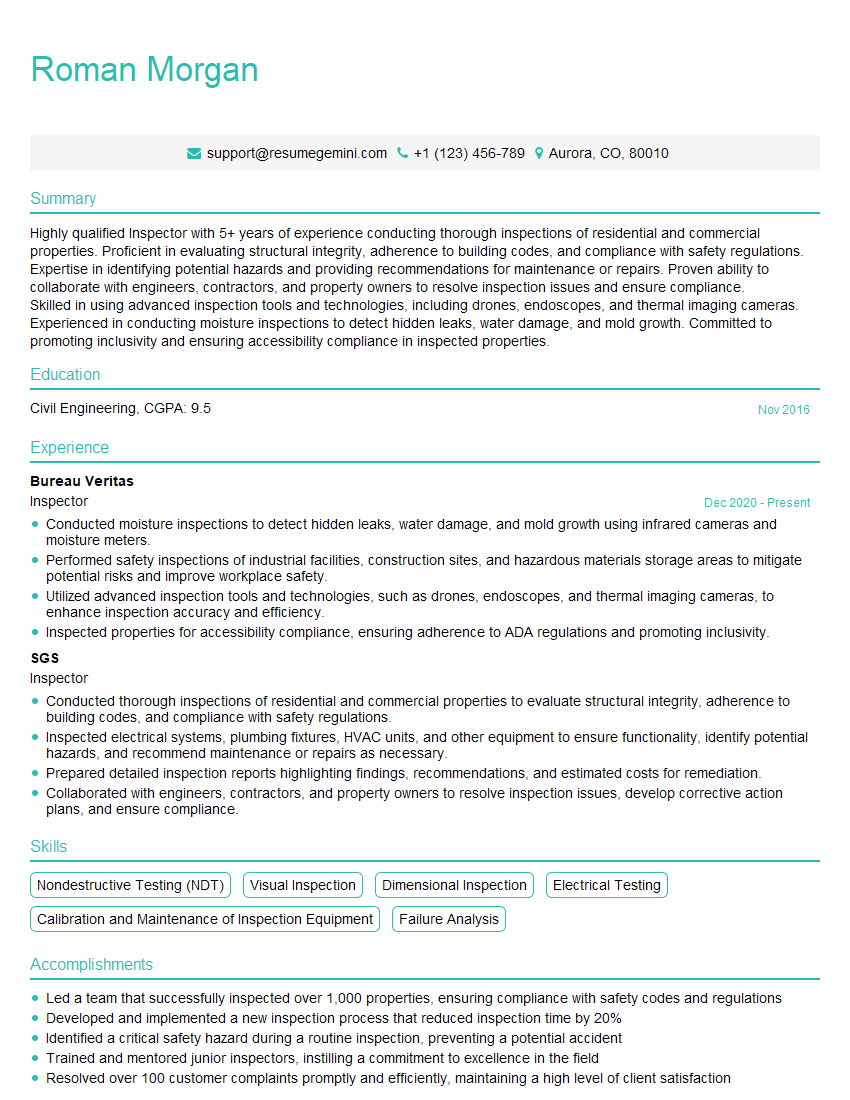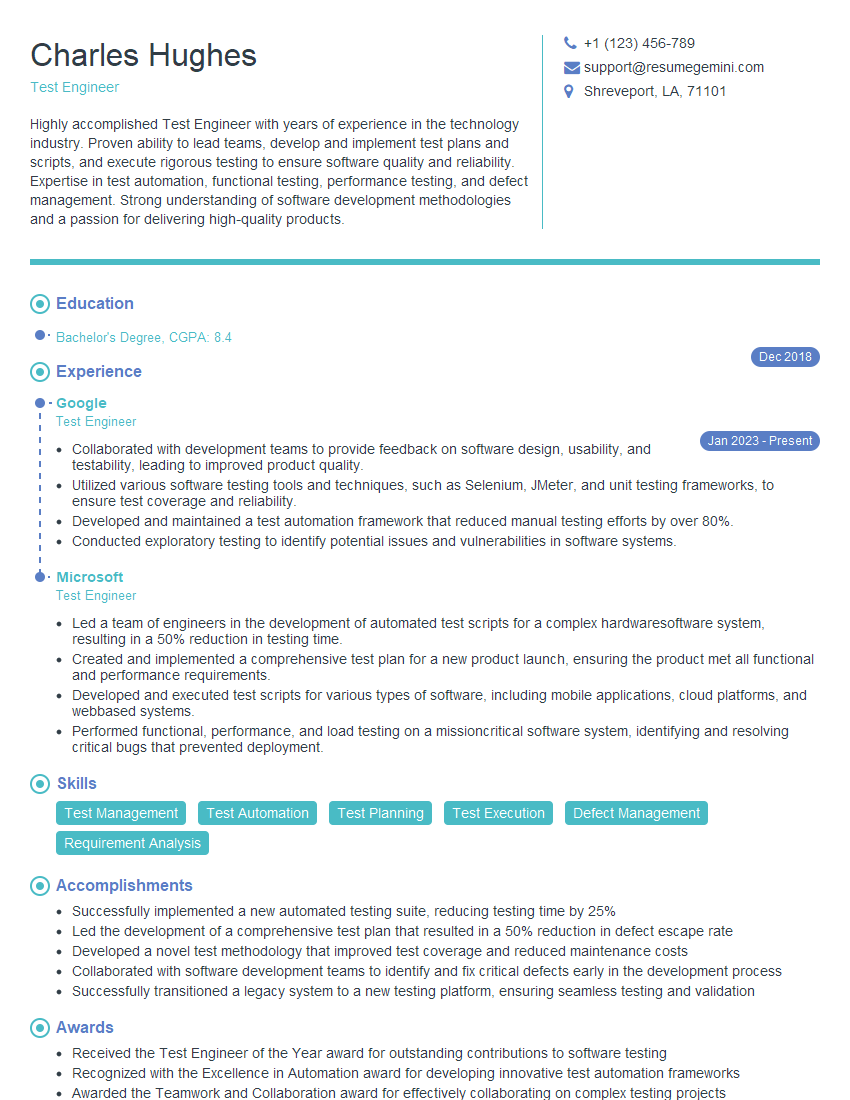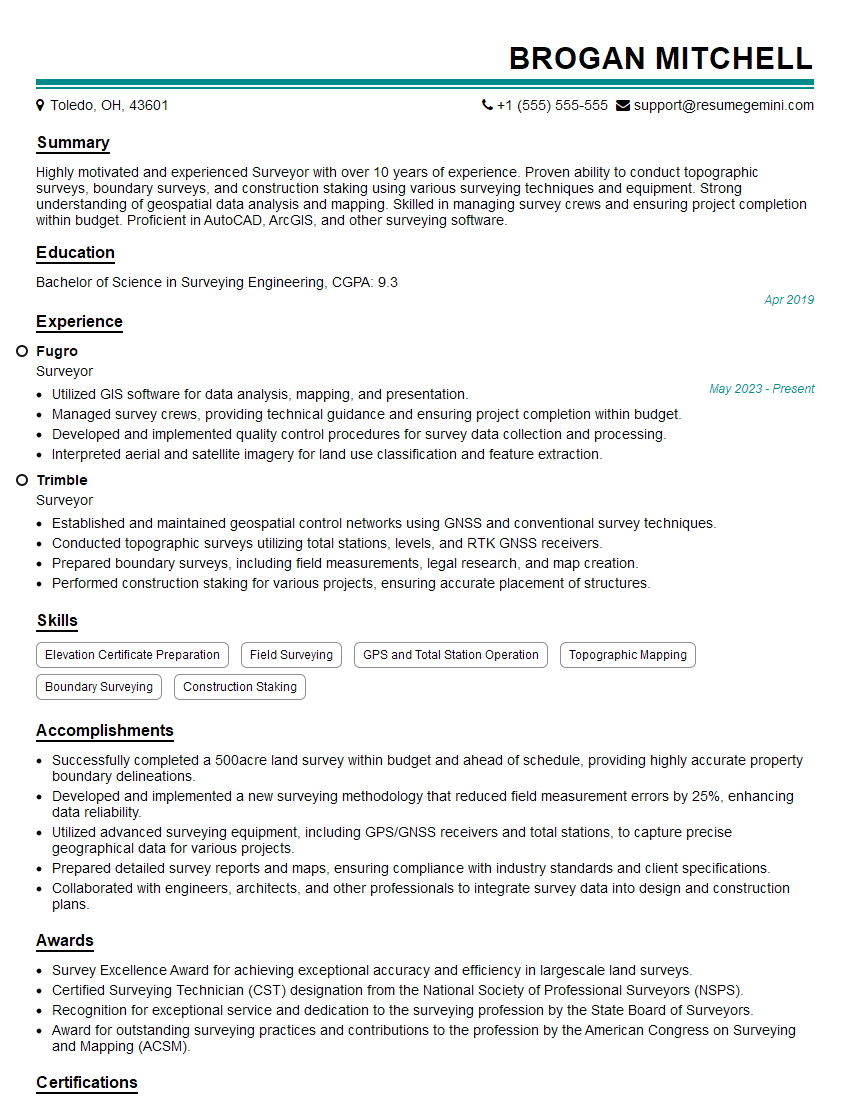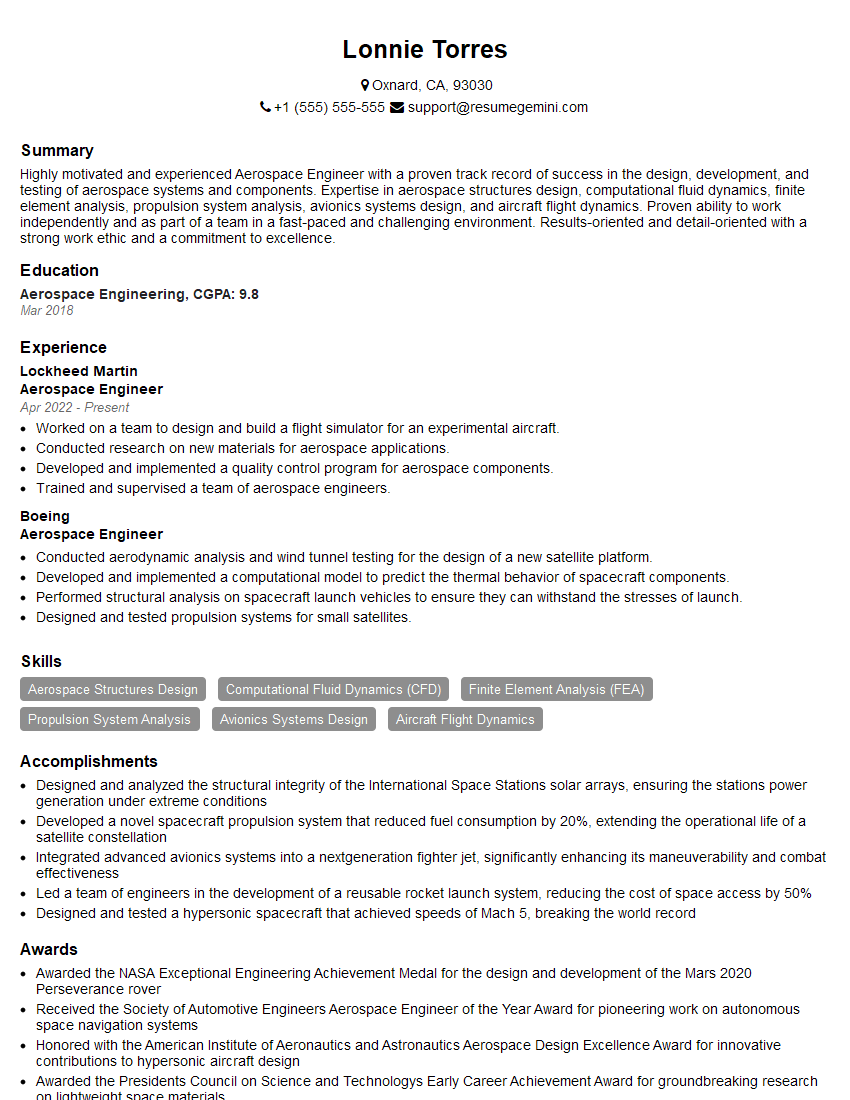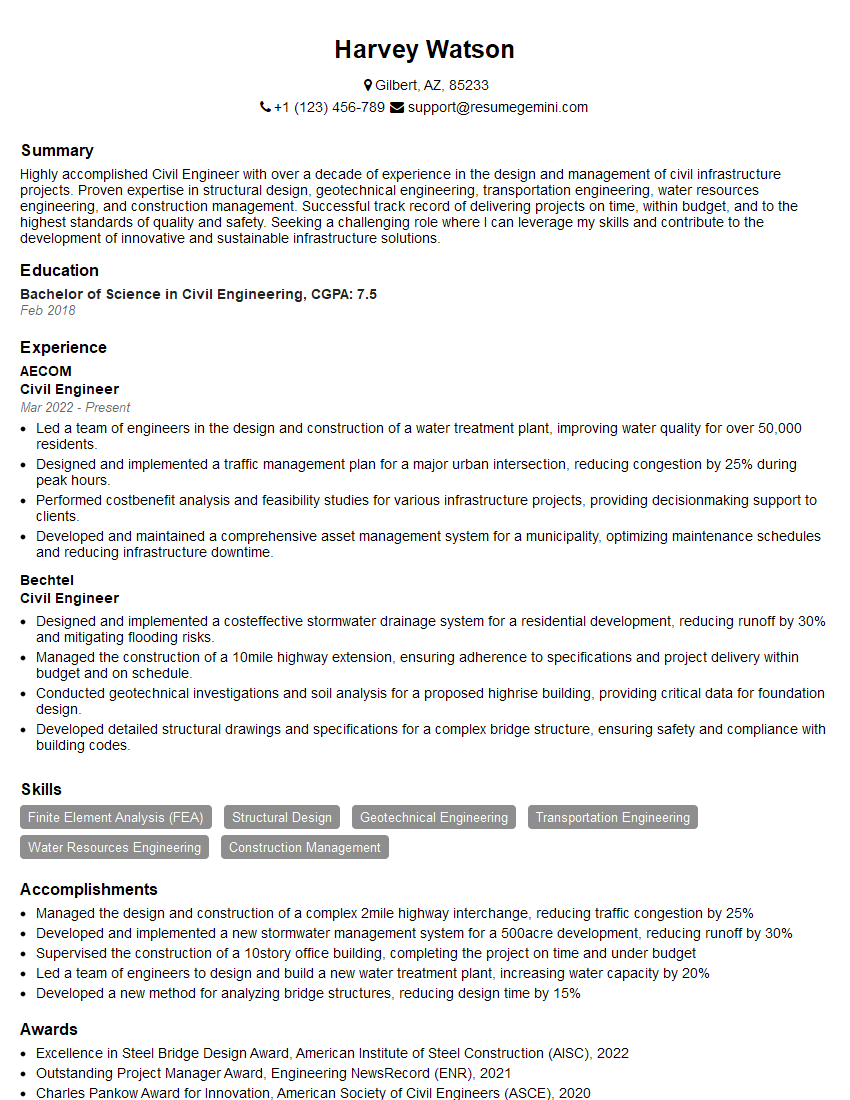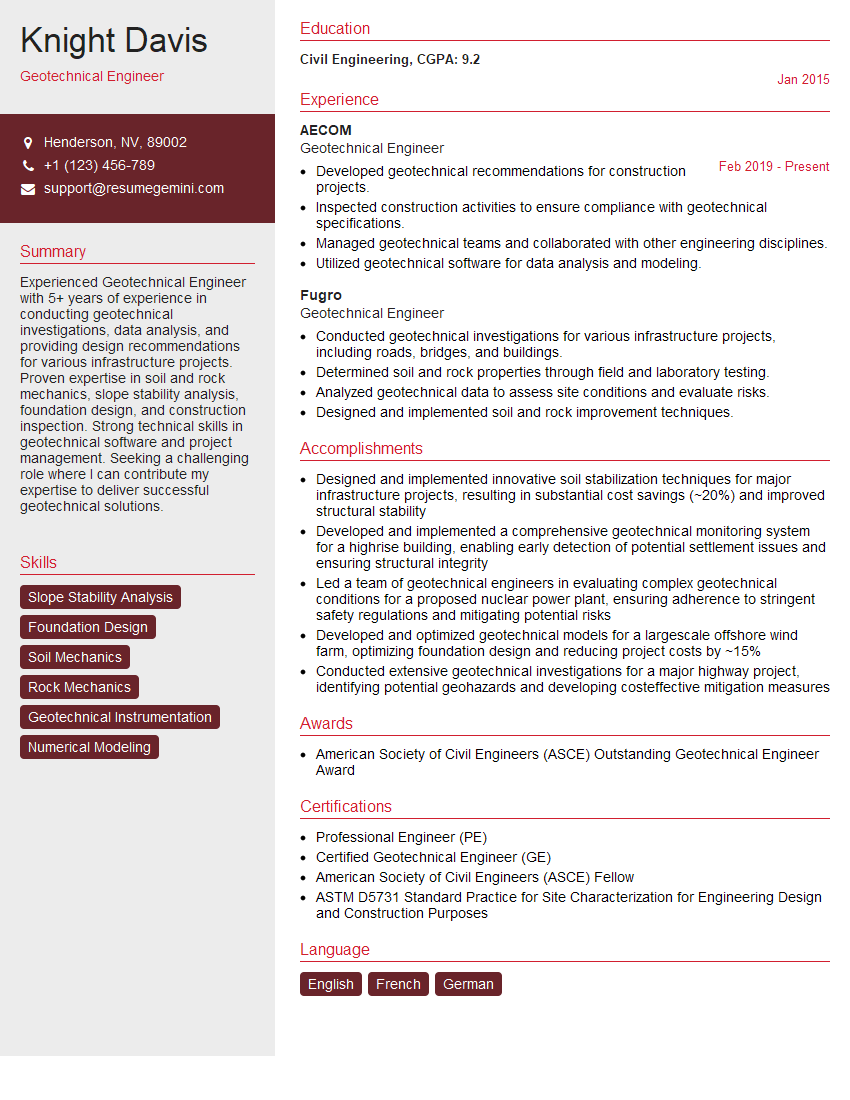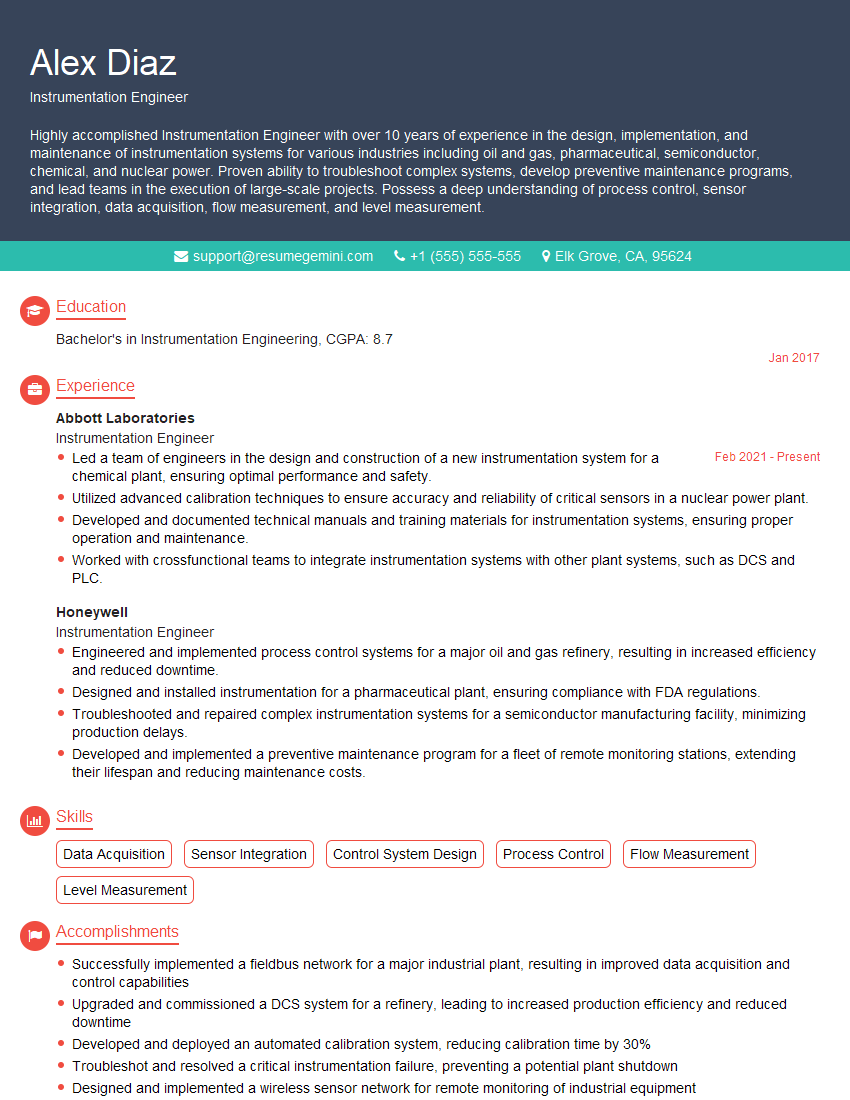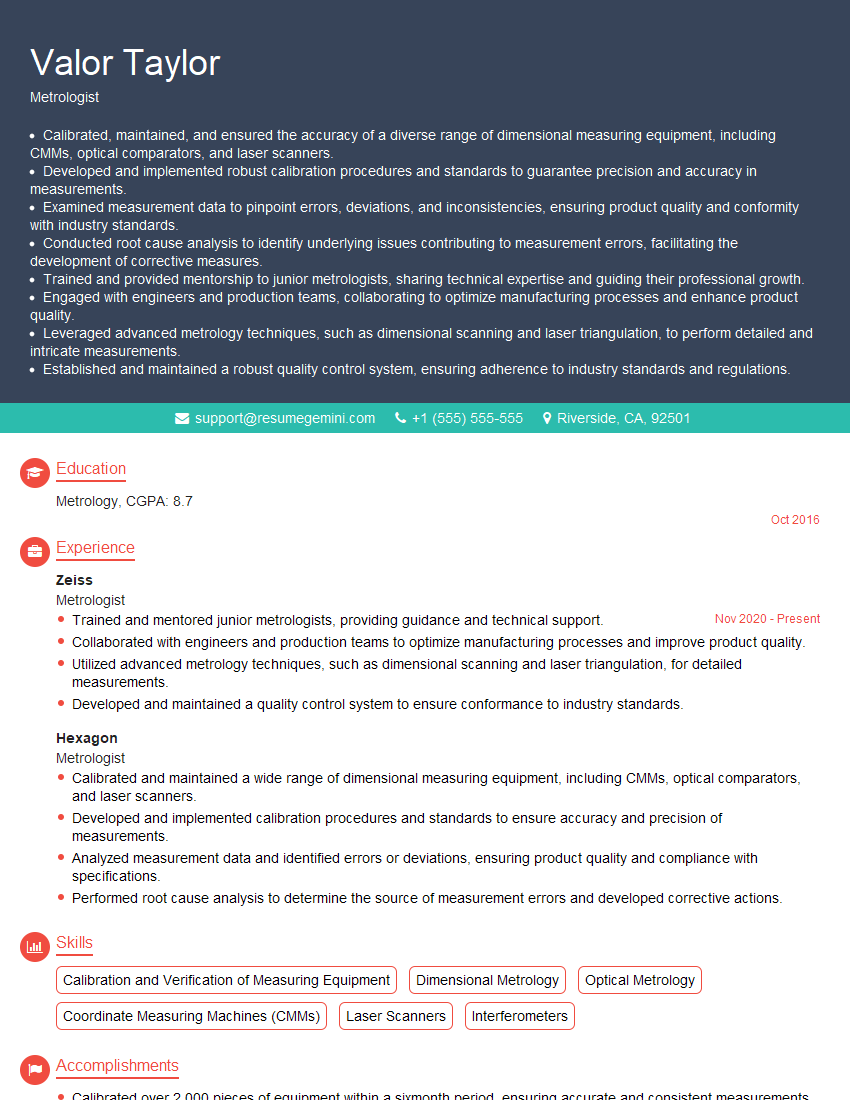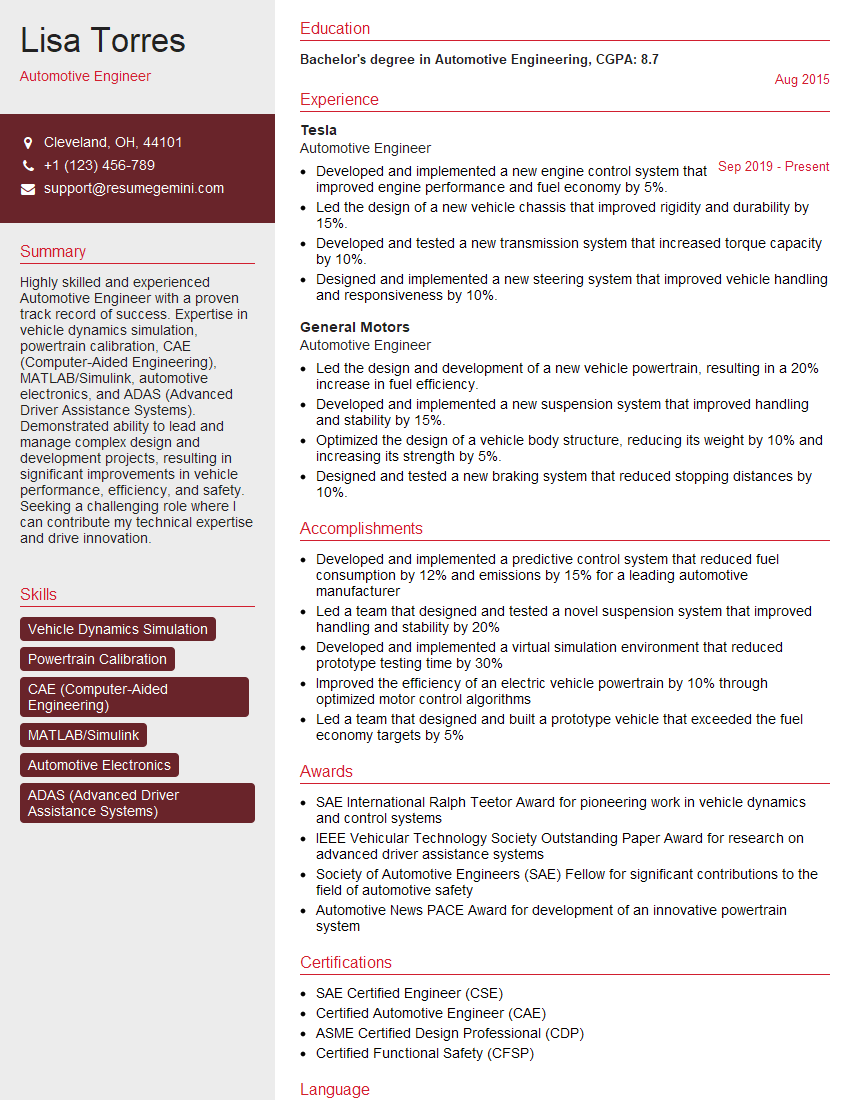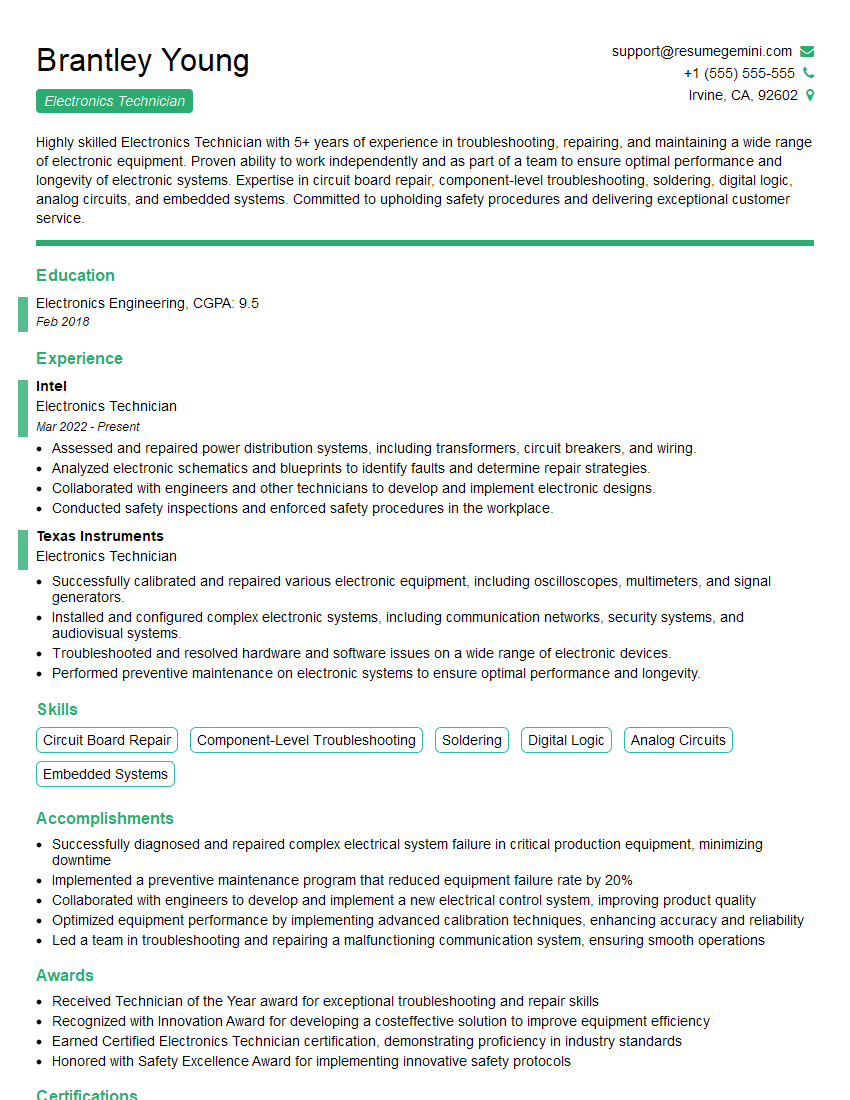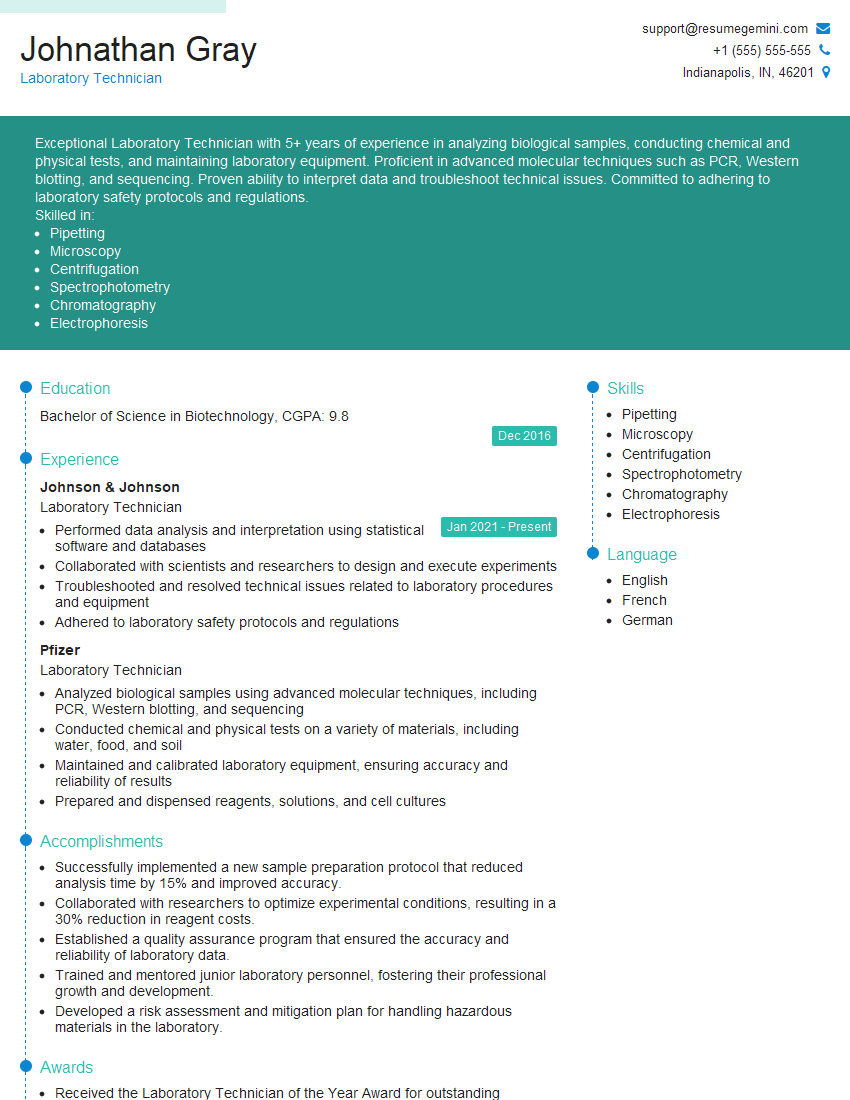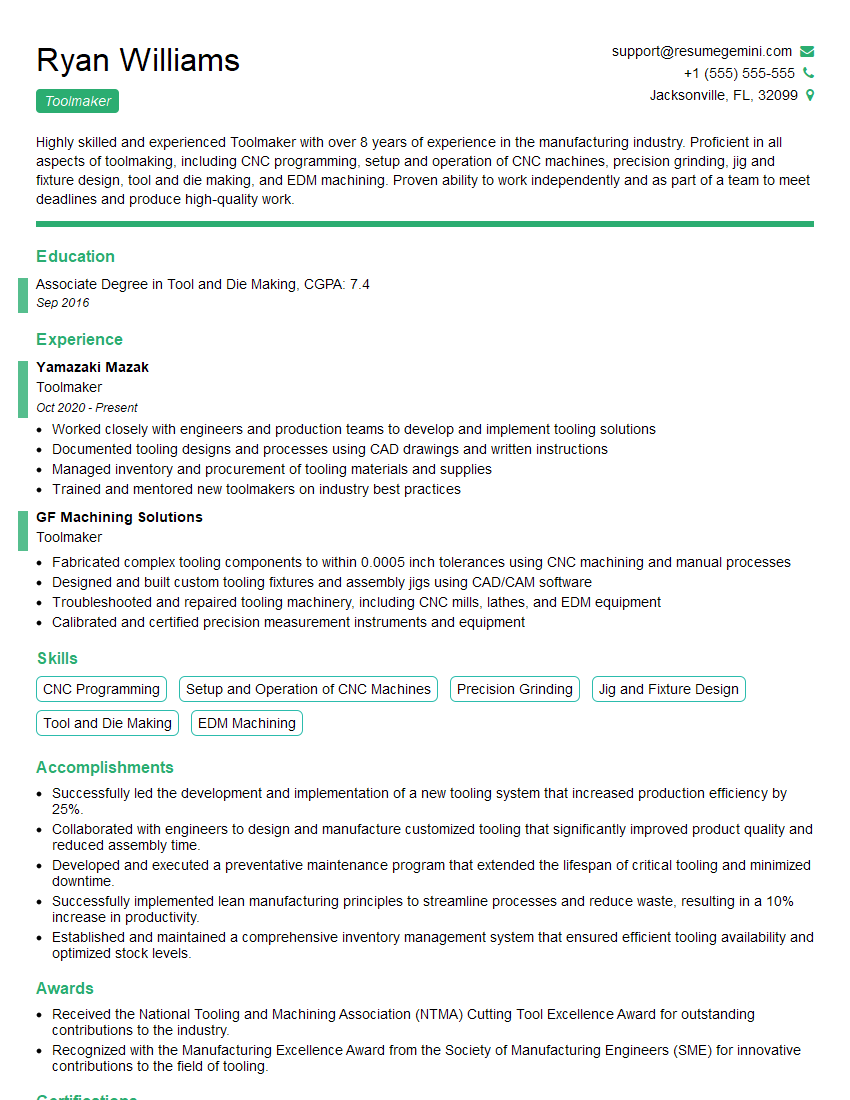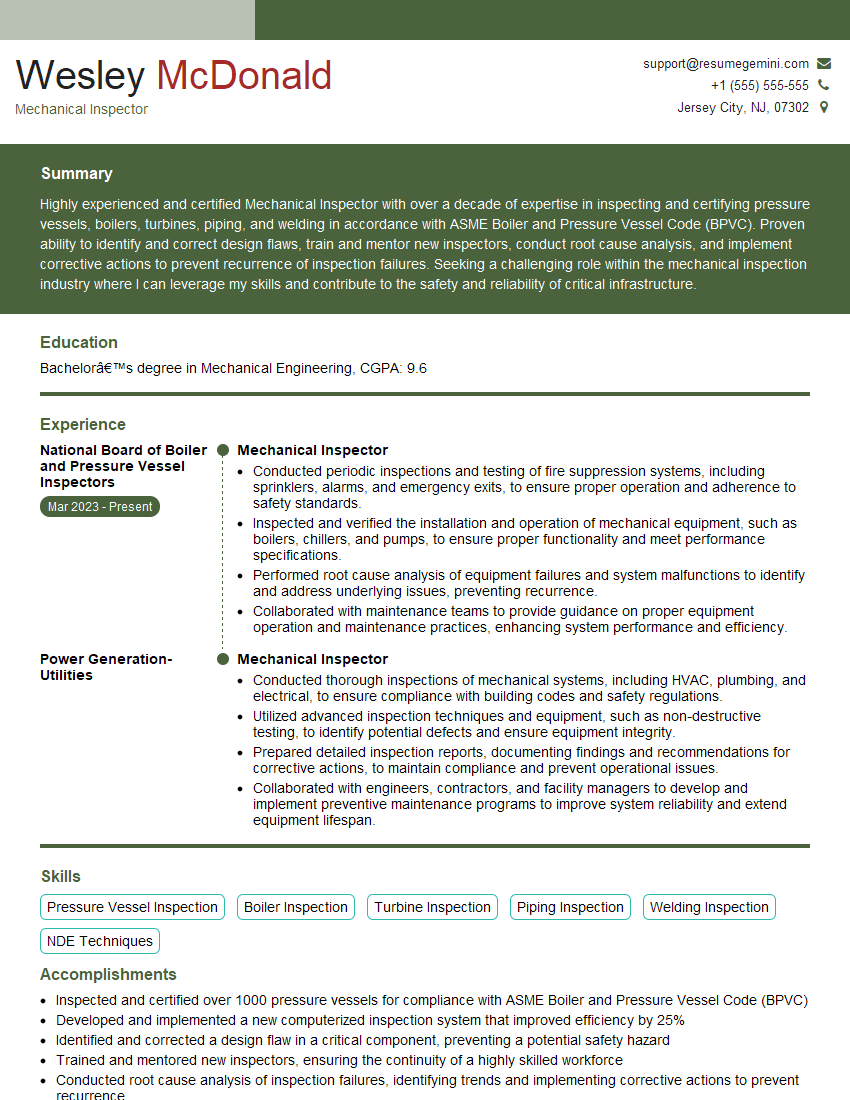The right preparation can turn an interview into an opportunity to showcase your expertise. This guide to Use precision measuring instruments interview questions is your ultimate resource, providing key insights and tips to help you ace your responses and stand out as a top candidate.
Questions Asked in Use precision measuring instruments Interview
Q 1. What types of precision measuring instruments are you familiar with?
I’m familiar with a wide range of precision measuring instruments, crucial for ensuring accuracy in various industries. These include:
- Micrometers: Used for extremely precise linear measurements, typically down to 0.001mm or 0.0001 inches.
- Digital Calipers: Versatile instruments providing both internal, external, depth, and step measurements, with digital readout for improved accuracy and ease of use.
- Dial Indicators (Dial Gauges): Measure small displacements or variations in surface flatness, crucial for detecting minute deviations from a reference point.
- Optical Comparators: Project magnified images of parts to allow for precise measurement and inspection of complex shapes and features.
- Coordinate Measuring Machines (CMMs): Used for high-precision 3D measurements, often employed in quality control and manufacturing for inspecting complex parts.
- Leveling Instruments: For ensuring accurate alignment and flatness, essential in surveying, construction, and machine setup.
My experience encompasses the use and maintenance of these instruments across diverse applications, from manufacturing to metrology.
Q 2. Explain the principle of operation for a micrometer.
A micrometer operates on the principle of precise screw-thread measurement. It consists of a precisely machined screw (the spindle) that moves within a fixed nut. The spindle has a precisely known pitch (distance between adjacent threads). When you turn the thimble (the rotating part), the spindle moves linearly, engaging with the anvil. The distance between the anvil and the spindle’s tip corresponds to the measured object’s dimension. The thimble is graduated in smaller increments, usually 0.01mm, allowing for extremely fine measurements. The main scale indicates larger increments and is read in conjunction with the thimble scale for the complete measurement. Think of it like a highly refined screw-based ruler.
For example, if the main scale shows 5mm and the thimble shows 0.25mm, the total measurement is 5.25mm. The design ensures a high degree of precision through controlled mechanical movement and accurate calibrations.
Q 3. How do you calibrate a digital caliper?
Calibrating a digital caliper involves ensuring it provides accurate readings. Most digital calipers offer a zeroing function. To calibrate, first ensure the jaws are clean and closed tightly. Press the ‘zero’ button while the jaws are closed. This sets the zero point. Then, measure a known, precisely dimensioned gauge block (a precisely manufactured standard). If there’s a discrepancy, adjust the zero offset until the reading matches the gauge block’s value. The adjustment process is specific to the caliper model and should be performed according to the manufacturer’s instructions.
Regular calibration using certified gauge blocks is essential to maintain accuracy, typically before each use or at specific intervals depending on usage frequency and the required precision level.
Q 4. Describe the process of verifying the accuracy of a dial indicator.
Verifying the accuracy of a dial indicator involves checking its repeatability and measuring its accuracy against a known standard. This is typically done using a test stand and a precisely calibrated gauge or master. The process involves:
- Mounting the indicator: Securely mount the dial indicator on the test stand.
- Zeroing the indicator: Adjust the indicator to show zero when the plunger is not contacting the test surface.
- Performing measurements: Make multiple measurements at various points along the test range, recording the readings.
- Analyzing repeatability: Check for consistent readings. High variability indicates a potential problem with the indicator’s mechanism.
- Comparing to a standard: Use a calibrated gauge block or a master to check the indicator’s accuracy across its measuring range. Significant discrepancies may require recalibration or replacement.
Inconsistencies or significant deviations from the standard highlight the need for repair or replacement of the indicator to maintain precise readings.
Q 5. What are the common sources of error in precision measurements?
Several factors contribute to errors in precision measurements. These include:
- Instrument error: Wear and tear, miscalibration, or inherent limitations in the instrument’s design.
- Environmental factors: Temperature changes, humidity, and vibrations can all affect readings.
- Operator error: Incorrect handling, parallax error (reading the scale from an angle), or misinterpretation of readings.
- Workpiece factors: Surface irregularities, workpiece deformation, or contamination on the measured surface can affect results.
- Measurement technique: Incorrect application of the instrument or improper clamping can lead to inaccurate readings.
Understanding and mitigating these sources of error is crucial for obtaining reliable and repeatable measurements.
Q 6. How do you handle measurement uncertainty?
Measurement uncertainty is inherent in all measurements and reflects the range of values within which the true value likely lies. Handling uncertainty involves:
- Identifying sources of uncertainty: Carefully analyze the potential sources of error in your measurement process.
- Quantifying uncertainty: Use statistical methods to estimate the magnitude of the uncertainty associated with each source.
- Combining uncertainties: Combine the individual uncertainties to determine the overall measurement uncertainty.
- Reporting uncertainty: Clearly state the measurement uncertainty alongside the measured value (e.g., 10.00 ± 0.05mm). This communicates the reliability of the result.
Effective uncertainty analysis provides a realistic picture of the measurement’s accuracy, guiding decision-making in quality control and engineering applications.
Q 7. Explain the difference between accuracy and precision.
Accuracy and precision are distinct concepts in measurement. Accuracy refers to how close a measurement is to the true value, while precision refers to how close repeated measurements are to each other.
Analogy: Imagine shooting arrows at a target. High accuracy means the arrows are clustered around the bullseye (close to the true value). High precision means the arrows are clustered tightly together, regardless of whether they’re near the bullseye or not. You can have high precision but low accuracy (arrows clustered far from the bullseye), high accuracy but low precision (arrows scattered around the bullseye), or ideally, both high accuracy and high precision (arrows tightly clustered around the bullseye).
Q 8. What is the significance of traceability in measurement?
Traceability in measurement is crucial for ensuring the reliability and accuracy of our findings. It’s the ability to trace a measurement back to a known standard, demonstrating a clear, unbroken chain of comparison. Think of it like a family tree for your measurement – each step is linked to the one before it, ultimately leading back to a nationally or internationally recognized standard. This is essential because if a measurement is incorrect, traceability helps pinpoint the source of error. Without it, we’re working with potentially flawed data, which can have serious consequences in various fields, from manufacturing to scientific research. For example, if a manufacturer is producing parts for aerospace, the dimensions must be precisely controlled, and traceability ensures that every single measurement is verifiable against a known and accepted standard.
In simpler terms, traceability ensures that if someone else were to conduct the same measurement with different equipment, they should obtain a similar result within the accepted tolerances. This consistency is paramount for quality control, product safety, and scientific integrity.
Q 9. How would you measure the diameter of a small hole?
Measuring the diameter of a small hole requires specialized tools, as standard calipers or micrometers might not be suitable. One common method involves using a pin gauge set. Pin gauges are precisely sized cylindrical pins that can be inserted into the hole. By finding the largest pin that fits snugly, we determine the minimum diameter. Conversely, to find the maximum diameter, we’d utilize a plug gauge that fits closely inside the hole and note the size. A more precise method involves using an optical comparator or a coordinate measuring machine (CMM). These devices provide a magnified image of the hole, allowing for accurate digital measurement using software and high-resolution cameras.
For example, let’s say we are measuring the diameter of a small fuel injector nozzle. We might start with a pin gauge set to determine the minimum diameter, then use an optical comparator to get the extremely precise diameter to verify tolerance against design specification.
Q 10. How would you measure the thickness of a thin sheet of metal?
Measuring the thickness of a thin sheet of metal demands precision and often requires a specialized instrument. A micrometer is an excellent choice for measuring relatively thicker sheets (more than a few hundred micrometers). However, for extremely thin sheets (e.g., foil), a digital micrometer is preferred for better readability. In some cases, for even greater accuracy, we may use a dial gauge-based thickness tester. This often incorporates a high-quality dial indicator and a heavy base, so vibrations do not compromise the accuracy. Another, less precise method is to stack many sheets and measure the combined thickness, then divide by the number of sheets to find an average thickness. However, this method introduces errors from variations between sheets.
An example of a professional situation where this is crucial is in the manufacturing of electronic components where the thickness of insulation layers on circuit boards must be carefully measured to ensure circuit integrity.
Q 11. Describe your experience with different types of measurement standards.
My experience encompasses a range of measurement standards, from national standards maintained by organizations like NIST (National Institute of Standards and Technology) to international standards defined by organizations like ISO (International Organization for Standardization). I’ve worked extensively with calibration certificates that trace measurements back to these standards. These certificates are critical for verifying the accuracy of our measuring instruments. I’m familiar with various types of standards, including length standards (using gage blocks), mass standards (using weights), and electrical standards (using resistance and voltage references). Furthermore, I have experience working with internal company standards, developed to meet specific manufacturing requirements and tolerances. These standards are carefully defined and traceable to national or international standards, ensuring consistency within our production processes. The understanding of these diverse standards ensures the validity of our measurements, regardless of the instruments and methods used.
Q 12. What are the limitations of optical comparators?
Optical comparators, while powerful tools for dimensional inspection, have limitations. Primarily, their accuracy is affected by the quality of the projected image, potential magnification errors, and operator subjectivity. The resolution can be limited, especially when measuring extremely small features. Environmental factors, such as temperature fluctuations, can also impact their accuracy. Furthermore, the operator’s skill in interpreting the image and making accurate measurements significantly influences the precision. Lastly, they are typically not suitable for measuring complex shapes or three-dimensional objects easily.
Imagine trying to measure a very small and intricately shaped part. While an optical comparator can provide an enlarged view, measuring its precise dimensions might still be challenging because of the limitations mentioned above.
Q 13. How do you select the appropriate measuring instrument for a specific task?
Selecting the right measuring instrument is crucial for accurate results. The choice depends on several factors: the size and shape of the object, the required accuracy, the material of the object, and the available resources. For instance, measuring the length of a long metal bar might require a steel tape measure or laser measuring tool for high accuracy, whereas measuring the diameter of a small screw would utilize a micrometer or vernier caliper. When dealing with delicate components, non-contact measurement methods (e.g., optical techniques) might be necessary to avoid causing damage. Budget considerations also play a role – high-precision instruments can be quite expensive. Therefore, selecting an instrument necessitates carefully considering all these elements to ensure both accuracy and efficiency.
For instance, if I need to measure the thickness of a thin film, I wouldn’t use calipers; I would use a specialized instrument like a surface profilometer.
Q 14. Explain your experience with statistical process control (SPC) in relation to measurements.
Statistical Process Control (SPC) is integral to ensuring measurement quality and consistency. In my experience, SPC involves using control charts to monitor measurements over time. By plotting data points, we can identify trends, detect variations, and determine if a process is operating within acceptable limits. If the measurements fall outside predetermined control limits, it signifies a potential problem, requiring investigation and corrective action. This helps us pinpoint sources of variability and improve the consistency and reliability of our measurements. I’ve used SPC techniques extensively in manufacturing settings to monitor dimensions, weights, and other critical parameters, helping identify and mitigate potential defects before they impact product quality or customer satisfaction.
For example, if we’re monitoring the diameter of a manufactured part, we’d plot the measurements on a control chart. If a sudden trend appears, showing that the diameter is consistently outside specifications, we know that there’s a problem in the process and we would start investigation to identify its root cause.
Q 15. How do you document and report measurement results?
Documenting and reporting measurement results is crucial for maintaining accuracy and traceability. It involves a systematic approach ensuring clarity and reproducibility.
- Data Sheet/Logbook: Each measurement should be meticulously recorded in a dedicated logbook or data sheet. This includes the instrument used (with its identification number), date, time, environmental conditions (temperature, humidity), the measured value, and any relevant observations (e.g., surface finish imperfections). For example, ‘Micrometer #12345, 2024-10-27, 10:00 AM, 22°C, 50% RH, Measured Diameter: 10.002 mm ± 0.001 mm.’
- Statistical Analysis: For multiple measurements, statistical analysis like calculating mean, standard deviation, and range helps determine the precision and accuracy of the results. This data is often presented in tables or graphs.
- Calibration Certificates: Calibration certificates for the used instruments should be referenced in the report to demonstrate the instruments’ accuracy and validity.
- Reporting Format: The final report should be well-structured and concise. It needs to clearly state the measurement objective, methodology, results, and any conclusions drawn. The use of clear tables and charts greatly improves readability.
Imagine measuring the diameter of a precision shaft. A poorly documented result would be useless in manufacturing. A well-documented result with statistical analysis supports quality control and troubleshooting.
Career Expert Tips:
- Ace those interviews! Prepare effectively by reviewing the Top 50 Most Common Interview Questions on ResumeGemini.
- Navigate your job search with confidence! Explore a wide range of Career Tips on ResumeGemini. Learn about common challenges and recommendations to overcome them.
- Craft the perfect resume! Master the Art of Resume Writing with ResumeGemini’s guide. Showcase your unique qualifications and achievements effectively.
- Don’t miss out on holiday savings! Build your dream resume with ResumeGemini’s ATS optimized templates.
Q 16. Describe your experience with CMM (Coordinate Measuring Machine) operation.
I have extensive experience operating Coordinate Measuring Machines (CMMs), including both manual and automated systems. My experience encompasses various CMM types, such as bridge-type and gantry-type machines. I’m proficient in programming CMMs using various software packages (as detailed in the next answer) to perform complex measurements on a variety of parts including intricate castings, machined components, and assembled units.
My skills include:
- Probe Selection and Calibration: Selecting the appropriate probes (touch trigger, scanning, etc.) and ensuring their accurate calibration is critical for reliable results.
- Part Programming: Creating efficient and accurate measurement programs using CAD models, ensuring all critical dimensions and features are captured.
- Data Acquisition and Analysis: Acquiring measurement data, and analyzing it using statistical methods to identify deviations from specifications.
- Troubleshooting: Diagnosing and resolving issues related to probe malfunctions, software errors, and machine alignment.
For instance, I recently used a CMM to inspect a complex aerospace component, ensuring its dimensions met stringent tolerances. The automated program I developed significantly reduced inspection time and improved accuracy compared to manual methods.
Q 17. What software are you proficient in for data acquisition and analysis of measurement data?
I am proficient in several software packages for data acquisition and analysis of measurement data. This includes:
- PC-DMIS: A widely used CMM software that facilitates programming, data acquisition, and analysis.
- Calypso: Another powerful CMM software package known for its advanced features and reporting capabilities.
- PolyWorks: This software is useful for reverse engineering and 3D scanning data analysis, often used in conjunction with CMM data.
- Microsoft Excel & Statistical Software (e.g., Minitab): For basic data manipulation and advanced statistical analysis, creating graphs and reports.
My expertise extends to using these software packages to generate comprehensive reports including detailed dimensional analysis, geometric tolerance verification, and statistical process control (SPC) charts. For example, using PC-DMIS, I can create programs to automatically measure complex parts, and then generate reports indicating whether the part meets specifications, including graphical representations highlighting any deviations.
Q 18. How do you troubleshoot a malfunctioning measuring instrument?
Troubleshooting a malfunctioning measuring instrument requires a systematic approach. The process starts with identifying the symptoms and then systematically investigating potential causes.
- Visual Inspection: Begin with a thorough visual inspection for any physical damage, loose connections, or obvious signs of malfunction.
- Calibration Check: Verify the instrument’s calibration status. An out-of-calibration instrument will produce inaccurate results. A recalibration may be needed.
- Functional Test: Perform a series of functional tests using known standards or reference objects to isolate the problem. This might involve checking the instrument’s zero setting, linearity, and repeatability.
- Environmental Factors: Consider environmental factors like temperature and humidity that could affect instrument performance. Ensure the instrument is operating within its specified environmental limits.
- Consult Documentation: Refer to the instrument’s user manual or service documentation for troubleshooting guidance and potential solutions.
- Seek Expert Assistance: If the problem persists, contact the instrument manufacturer or a qualified service technician.
For example, if a micrometer consistently gives a reading that’s slightly off, a calibration check is the first step. If the issue is not resolved by calibration, then a more thorough inspection for mechanical wear or damage is necessary.
Q 19. What safety precautions do you take when using precision measuring instruments?
Safety is paramount when using precision measuring instruments. My safety practices include:
- Proper Training: I ensure I am properly trained on the operation and safe handling of each instrument before use.
- Personal Protective Equipment (PPE): I use appropriate PPE such as safety glasses to protect my eyes from potential hazards, including flying debris or splashes.
- Careful Handling: I handle instruments with care, avoiding drops or impacts that could damage them or cause injury. I use appropriate handling techniques.
- Cleanliness: I maintain a clean and organized workspace to prevent accidents caused by clutter or spills.
- Awareness of Surroundings: I maintain awareness of my surroundings to prevent collisions or injuries while operating instruments.
- Following Manufacturer Instructions: I always follow the manufacturer’s instructions for operating and maintaining each instrument.
For example, when using a CMM, I ensure the work area is clear of obstructions to prevent accidental collisions. I also regularly check for any loose parts or potential hazards before commencing operation.
Q 20. How do you maintain and care for precision measuring instruments?
Maintaining and caring for precision measuring instruments is crucial for their accuracy and longevity. My approach includes:
- Regular Cleaning: I regularly clean the instruments using appropriate cleaning solutions and soft cloths, following manufacturer’s recommendations. This prevents dirt and debris from affecting measurements.
- Proper Storage: I store instruments in appropriate cases or environments to protect them from dust, moisture, and extreme temperatures.
- Calibration Schedule: I adhere to a regular calibration schedule, ensuring that the instruments are calibrated and certified by a qualified lab at recommended intervals.
- Lubrication (if applicable): I lubricate moving parts according to the manufacturer’s instructions, ensuring smooth operation and reducing wear.
- Careful Handling: I handle instruments with care, avoiding drops or impacts.
- Documentation: I maintain detailed records of cleaning, calibration, and maintenance activities.
Think of it like caring for a high-precision watch—regular cleaning, lubrication, and professional servicing ensure it continues to function accurately and reliably.
Q 21. Describe a time you had to solve a complex measurement problem.
I once encountered a complex measurement challenge involving a newly designed turbine blade with intricate internal cooling channels. Traditional contact measurement methods were not suitable due to the delicate nature of the channels and the difficulty of accessing them.
My solution involved a multi-faceted approach:
- 3D Scanning: We employed a high-resolution 3D scanner to capture the blade’s external and internal geometry.
- Software Analysis: Using PolyWorks software, we processed the scan data to create a precise 3D model of the blade, including the internal cooling channels. This allowed for highly accurate dimensional analysis.
- Comparison with CAD Model: The 3D model was then compared to the CAD design model to identify any deviations in dimensions and geometry.
- Reporting: A detailed report was generated, highlighting the areas of deviation and their impact on performance.
This non-contact approach provided a much more accurate and comprehensive measurement than traditional contact methods, successfully resolving the complex measurement problem and ensuring that the turbine blade met the design specifications. This experience highlighted the importance of using the right tools and technologies for specific measurement tasks.
Q 22. What are the different units of measurement and their conversions?
Precision measurements utilize a variety of units, depending on the quantity being measured. The most common are length, mass, and time, each with its own system and conversions.
- Length: The most common units are millimeters (mm), centimeters (cm), meters (m), and kilometers (km) in the metric system, and inches (in), feet (ft), yards (yd), and miles (mi) in the imperial system. Conversions are straightforward; for example, 1 m = 100 cm = 1000 mm. We often use micrometers (µm) and nanometers (nm) for extremely precise measurements.
- Mass: The metric system uses grams (g), kilograms (kg), and tonnes (t), while the imperial system employs ounces (oz), pounds (lb), and tons. 1 kg = 1000 g. We might encounter milligrams (mg) or micrograms (µg) in delicate scientific measurements.
- Time: Seconds (s), minutes (min), hours (hr), days, etc., are universally used. In specialized fields, we might deal with milliseconds (ms), microseconds (µs), or even smaller units.
Conversion factors are crucial. For instance, to convert inches to centimeters, we use the conversion factor 1 in ≈ 2.54 cm. Understanding these conversions ensures accurate data interpretation and communication across different systems. In my work, I routinely convert between metric and imperial units depending on the project requirements and client specifications.
Q 23. Explain the concept of tolerance and its importance in precision measurements.
Tolerance in precision measurement refers to the permissible variation from a specified value. It defines the acceptable range within which a measurement can fall and still be considered accurate. For example, a shaft specified as 10.00 mm ± 0.02 mm means the acceptable diameter range is between 9.98 mm and 10.02 mm.
Tolerance is paramount because it establishes acceptable quality standards. In manufacturing, exceeding tolerance limits might result in parts that don’t fit together properly, leading to malfunctioning equipment or even safety hazards. In construction, inaccuracies outside the tolerance limit can cause structural instability. Therefore, understanding and adhering to tolerances is vital for ensuring product reliability and safety.
For instance, I once worked on a project involving the production of microchips. Extremely tight tolerances were required for the dimensions of the circuit pathways because even minute deviations could affect the performance of the chip. A thorough understanding and application of tolerance limits were crucial to ensuring the successful completion of the project.
Q 24. How do you ensure the integrity of your measurements?
Ensuring measurement integrity involves several critical steps. First, instrument calibration is crucial. Precision instruments must be regularly calibrated against traceable standards to ensure accuracy. This ensures that the readings obtained are reliable and consistent. I use certified standards for all my calibrations. Second, proper instrument handling is essential. Following manufacturer’s instructions, using instruments within their specified range, and avoiding harsh environments (temperature fluctuations, excessive humidity) are vital. Third, environmental factors like temperature and humidity can affect measurements. This is particularly important for measurements of length and certain electrical properties, where environmental control may be necessary. Finally, thorough data recording and analysis using appropriate statistical methods help identify potential systematic errors and ensure the accuracy and validity of the measurements.
I always meticulously document each measurement, including the instrument used, its calibration date, environmental conditions, and any observations made during the process. This detailed record-keeping makes it easier to identify and correct errors or inconsistencies.
Q 25. What are your strengths and weaknesses related to precision measurement?
My strengths lie in my meticulous attention to detail and my deep understanding of various precision measurement techniques. I’m proficient in using a wide range of instruments, including micrometers, calipers, optical comparators, and laser interferometers. My systematic approach ensures that I address each measurement with precision and accuracy. I also possess strong analytical skills that allow me to quickly identify and resolve any anomalies or discrepancies.
One area I’m continually working to improve is my proficiency in advanced statistical analysis techniques for error reduction. While I have a solid foundation, I believe further training in this area would enhance my ability to optimize measurement processes and further reduce uncertainties. I actively seek out opportunities for professional development to address this weakness.
Q 26. What is your experience with different types of measurement scales?
My experience encompasses various measurement scales, including linear scales (using instruments like micrometers and calipers), angular scales (using protractors and goniometers), and digital scales (utilized in electronic instruments with digital displays). I am also proficient in interpreting and utilizing scales found on various specialized measurement tools.
For instance, I have experience with using Vernier calipers to measure external and internal diameters with high precision, interpreting the readings from the Vernier scale. Similarly, I have utilized optical comparators to measure complex geometries using projected images and their associated scales. Understanding these different scales and their limitations is essential for selecting the most appropriate tool for a specific measurement task.
Q 27. Describe your understanding of error propagation in measurements.
Error propagation refers to how uncertainties in individual measurements combine to affect the uncertainty in a calculated result. If a calculation uses multiple measured values, each with its own uncertainty, the overall uncertainty of the final result will be larger than the uncertainty of any single measurement. This is because the errors can accumulate or cancel each other out, resulting in a range of possible values for the final result.
A simple example is calculating the area of a rectangle. If the length (L) and width (W) are measured with uncertainties, the uncertainty in the calculated area (A = L x W) will be affected by the uncertainties in both L and W. The error propagation formula helps quantify this uncertainty. Understanding error propagation is crucial for assessing the reliability of calculated results and making informed decisions based on those results. In practice, I always consider error propagation when making calculations involving multiple measurements, enabling me to provide more realistic and reliable results. I carefully document each step of calculation, outlining the uncertainty in every measurement, and using appropriate error propagation techniques to find the overall uncertainty of the final result.
Key Topics to Learn for Use Precision Measuring Instruments Interview
- Understanding Measurement Units and Systems: Mastering the use of metric and imperial systems, including conversions and appropriate unit selection for different applications.
- Calibration and Error Analysis: Learn the importance of instrument calibration, identifying potential sources of error (e.g., systematic, random), and understanding how to minimize measurement uncertainty.
- Specific Instrument Operation: Gain proficiency in operating various precision measuring instruments, such as calipers, micrometers, dial indicators, and other relevant tools. Understand their limitations and applications.
- Practical Applications and Case Studies: Explore real-world examples of how precision measurement is used in different industries (e.g., manufacturing, engineering, quality control) and solve problems related to specific measurement scenarios.
- Data Recording and Interpretation: Practice recording accurate measurements, using appropriate significant figures, and interpreting the data to draw meaningful conclusions.
- Troubleshooting and Maintenance: Understand basic troubleshooting techniques for common instrument issues and learn about preventative maintenance procedures to ensure accuracy and longevity.
- Safety Procedures: Familiarize yourself with safety protocols associated with handling and using precision measuring instruments.
Next Steps
Mastering the use of precision measuring instruments is crucial for career advancement in numerous technical fields, opening doors to higher-paying roles and greater responsibility. A strong resume is your first step towards securing these opportunities. Creating an ATS-friendly resume significantly increases your chances of getting noticed by recruiters. To enhance your resume and make it stand out, we recommend using ResumeGemini, a trusted resource for building professional and effective resumes. ResumeGemini provides examples of resumes tailored specifically to roles requiring expertise in using precision measuring instruments, giving you a head start in showcasing your skills and experience effectively.
Explore more articles
Users Rating of Our Blogs
Share Your Experience
We value your feedback! Please rate our content and share your thoughts (optional).
What Readers Say About Our Blog
Hi, I’m Jay, we have a few potential clients that are interested in your services, thought you might be a good fit. I’d love to talk about the details, when do you have time to talk?
Best,
Jay
Founder | CEO
